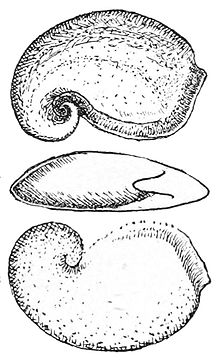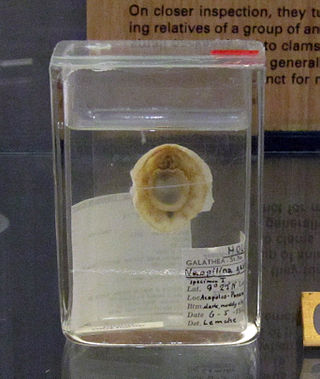
Monoplacophora, meaning "bearing one plate", is a polyphyletic superclass of molluscs with a cap-like shell, inhabiting deep sea environments. Extant representatives were not recognized as such until 1952; previously they were known only from the fossil record, and were thought to have become extinct 375 million years ago.

The Bellerophontida is a taxonomic order of extinct marine mollusks that are found in the fossil record from the Lower Cambrian to the Lower Triassic. They are considered by some experts to be primitive sea snails with primarily symmetrically coiled shells, marine gastropod mollusks.
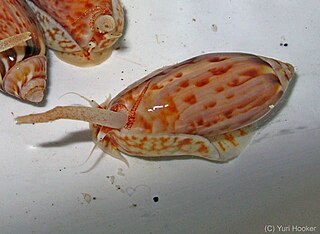
Olive snails, also known as olive shells and olives, scientific name Olividae, are a taxonomic family of medium to large predatory sea snails with smooth, shiny, elongated oval-shaped shells.

Latouchella is an extinct genus of marine invertebrate animal, that is considered to be a mollusk and which may be a sea snail, a gastropod. It is a helcionellid from the Tommotian epoch of what is now Siberia. Its tightly coiled, spiral shell contains a number of low "walls" running up the front surface of the interior; these would have directed water currents within its shell. Between these walls are a series of furrows, parallel to the shell's aperture, giving casts of the internal structure the appearance of a railway line, with sleepers tying together paired rails that run towards the apex of the shell.

Yochelcionella is an extinct genus of basal molluscs which lived during the Tommotian epoch, the first epoch of the Cambrian period. This genus is often reconstructed to resemble snails.
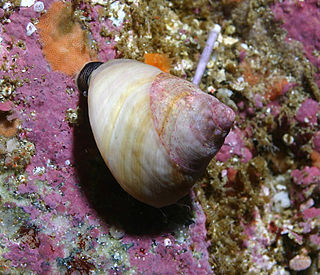
Trochoidea is a superfamily of small to very large vetigastropod sea snails with gills and an operculum. Species within this superfamily have nacre as the inner shell layer. The families within this superfamily include the Trochidae, the top snails. This superfamily is the largest vetigastropodan superfamily, containing more than 2,000 species.

Helcionellid or Helcionelliformes is an order of small fossil shells that are universally interpreted as molluscs, though no sources spell out why this taxonomic interpretation is preferred. These animals are first found about 540 to 530 million years ago in the late Nemakit-Daldynian age, which is the earliest part of the Cambrian period. A single species persisted to the Early Ordovician. These fossils are component of the small shelly fossils (SSF) assemblages.
The taxonomy of the Gastropoda, as revised by Winston Ponder and David R. Lindberg in 1997, is an older taxonomy of the class Gastropoda, the class of molluscs consisting of all snails and slugs. The full name of the work in which this taxonomy was published is Towards a phylogeny of gastropod molluscs: an analysis using morphological characters.

Coreospiridae is an extinct family of Paleozoic molluscs of uncertain position taxonomically. They might be snails (Gastropoda), Helcionelloida, or they might be Monoplacophora.
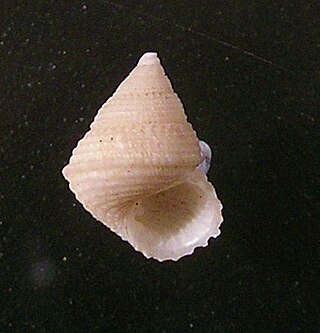
Seguenzioidea is a superfamily of minute to medium-sized sea snails, marine gastropod mollusks in the clade Vetigastropoda.
Khairkhaniidae is an extinct family of Paleozoic fossil molluscs of uncertain position. They are thought to belong to either the Gastropoda or Monoplacophora. They possess planispiral coiled shells with a columnar microstructure.
Aldanellidae is an extinct family of paleozoic molluscs that have been assigned to the Gastropod stem group but may also belong to a paraphyletic "Monoplacophora".

Pelagiellidae is an extinct family of Paleozoic fossil 'snails'. Some material assigned to this taxon represents gastropod molluscs, but some chaeta-bearing specimens first assigned to Pelagiella are perhaps better interpreted as tube-bearing annelid worms.
Carinopelta is a genus within Carinopeltidae, an extinct family of Cambrian molluscs of uncertain position. It is in the superfamily Scenelloidea.
Trenella is the sole genus in the Trenellidae, an extinct family of paleozoic Yochelcionellids.
Stenothecidae is an extinct family of fossil univalved Cambrian molluscs which may be either gastropods or monoplacophorans.

Yochelcionelloidea is an extinct superfamily of paleozoic molluscs of uncertain position. The earliest yochelcionellids are known from the Middle Tommotian, but they are most diverse from the Botomian through the early Middle Cambrian.
This overview lists proposed changes in the taxonomy of gastropods at the family level and above since 2005, when the taxonomy of the Gastropoda by Bouchet & Rocroi (2005) was published. In other words, these are recent updates in the way various groups of snails and slugs are classified.
The taxonomy of the Gastropoda as it was revised in December 2017 by Philippe Bouchet and eight other authors, is a publication which lays out a newly revised system for the scientific classification of gastropod mollusks. The same work also included the taxonomy of monoplacophorans.

Cocculinida is an order of deepwater limpets, in the subclass Neomphaliones.


